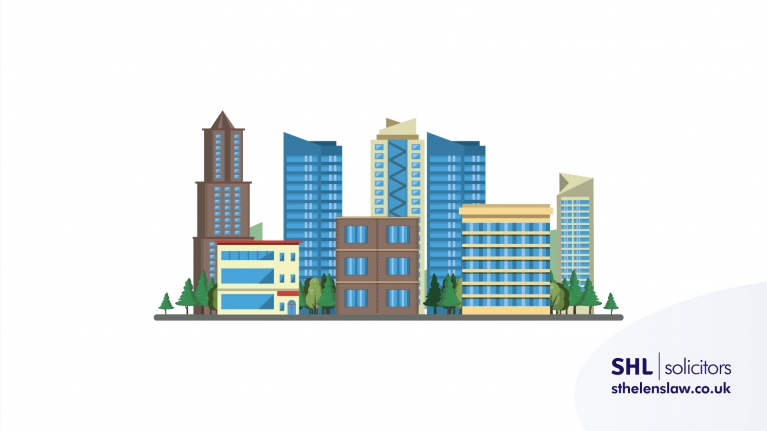Here at SHL Solicitors we are often instructed by a variety of commercial purchasers, landlords and tenants.
As a commercial landlord and/ or tenant, you should be aware that if you are intending to purchase, take a new lease or take an existing lease of a commercial premises in England, then the premises will probably have a certain use class for which it is expected to be used.
The Town and Country Planning (use Classes) Order 1987 (as amended), puts buildings and land into various categories based on their respective purpose(s).
Changing the use of a commercial property is not always as straightforward as making physical alterations to a property. An application to the Local Authority will often be required to change a building’s use.
A change of use can occur within the same use class or from one use class to another.
Below is an illustrative list of various use classes, along with examples of the types of building/ land that they relate to.
Use Class A
A1 – Shops & Retail
Examples include: Shops, retail warehouses, hairdressers, undertakers, travel and ticket agencies, post offices, pet shops, sandwich bars, showrooms, domestic hire shops, dry cleaners, funeral directors and internet cafes
A2 – Financial & Professional Services
Examples include Banks, building societies, estate and employment agencies, professional services (not health or medical services), job centres and tourist information
A3 – Restaurants & Cafes
Examples include: Properties selling food and drink for consumption on the premises – snack bars, but not hot food takeaways
A4 – Drinking establishments
Examples include: Public houses, wine bars or other drinking establishments (but not night clubs) including drinking establishments with expanded food provision
A5 – Hot food takeaways
Examples include: Properties selling hot food for consumption off the premises.
Use Class B
B1 – Businesses
This class is formed of three parts for Uses which can be carried out in a residential area without detriment to its amenity.
B1(a) – Offices other than a use within class A2 (not generally visited by members of the public)
B1(b) – Research & development of products or processes
B1(c) – Light industry appropriate in a residential area
Examples include: recording studios, non-retail photographic studios
B2 – General industrial other than one falling within class B1
(excludes incineration, chemical treatment, landfill or hazardous waste). Examples include: Car repair services and catering premises and production
B8 – Storage or distribution
Examples include: Buildings used for storage, warehouses, distribution centres and catering storage and distribution
Use Class C
C1- Hotels
Examples include: Hotels, boarding & guest houses (no significant element of care is provided) and bed and breakfasts (excluding hostels)
C2 – Residential institutions
Examples include: Residential care homes, hospitals, nursing homes, boarding schools, residential colleges and training centres
C2a – Secure residential institutions
Examples include: secure residential accommodation, prisons, young offenders institution, detention centre, secure training centre, custody centre, short term holding centre, secure hospital, secure local authority accommodation or use as a military barracks
C3 – Dwellinghouses
This class is formed of three parts:
C3(a) – covers use by a single person or a family (a couple whether married or not, a person related to one another with members of the family of one of the couple to be treated as members of the family of the other), an employer and certain domestic employees (such as an au pair, nanny, nurse, governess, servant, chauffeur, gardener, secretary and personal assistant), a carer and the person receiving the care and a foster parent and foster child
C3(b) – for houses where up to six people live together as a single household and receive care like supported housing schemes such as those for people with learning disabilities or mental health problems
C3(c) – allows for groups of people (up to six) living together as a single household. This allows for those groupings that do not fall within the C4 HMO definition, but which fell within the previous C3 use class, to be provided for i.e. a small religious community may fall into this section as could a homeowner who is living with a lodger
C4 – Houses in multiple occupation (HMO’s)
Examples include: Small shared houses occupied by between three and six unrelated individuals, as their only or main residence, who share basic amenities such as a kitchen or bathroom.
Use Class D
D1 – Non-residential institutions
Examples include: Clinics, health centres, creches, day nurseries, day centres, schools, art galleries (other than for sale or hire), museums, libraries, halls, places of worship, church halls, law court. Non-residential education and training centres
D2 – Assembly & leisure
Examples include: Cinemas, music and concert halls, bingo and dance halls (but not night clubs), swimming baths, skating rinks, gymnasiums or area for indoor or outdoor sports and recreations (except for motor sports, or where firearms are used)
Sui Generis
These are buildings used for certain purposes which are specifically excluded from any of the above classes by legislation. They therefore become unclassified.
Examples include: theatres, amusement arcades/centres or funfairs, launderettes, fuel stations, hiring, selling and/or displaying vehicles, taxi businesses, scrap yards, or a yard for the storage/distribution of minerals and/or the breaking of motor vehicles, Alkali work (any work registerable under the Alkali, etc. Works Regulation Act 1906 (as amended)), hostels (providing no significant element of care), waste disposal installations for the incineration, chemical treatment or landfill of hazardous waste, retail warehouse, clubs, nightclubs, casinos, betting offices/shops and pay day loan shops.
Contact us
For more advice on planning call on 01744 385171 or email us at info@sthelenslaw.co.uk today.


